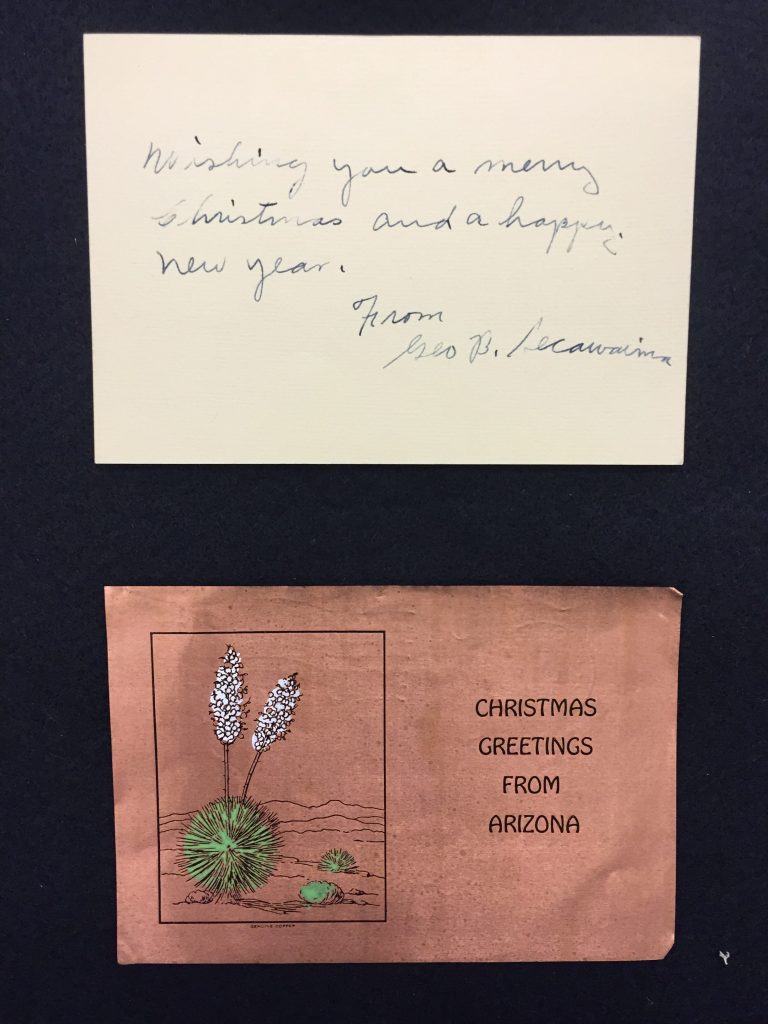The Wesleyan Collections, like many other anthropology and archaeology collections around the country and world, have a legacy of exploitative collecting practices – particularly relating to Native Americans. In 1990 the Native American Graves Protection and Repatriation Act (NAGPRA) was passed by Congress, drastically changing the relationship between museums and other collecting institutions – including Wesleyan – and Native tribes.
On Friday November 4th the collections co-sponsored an event titled “The Native American Graves Protection and Repatriation Act Revisited: Negotiating Culture, Legalities, and Challenges” to explore the intricacies of the law as well as its specific implications at Wesleyan. In the keynote address Suzan Harjo talked about the history of how NAGPRA came to be, and her own involvement in its development, starting in 1967. Her talk was followed by a panel, moderated by Professor J. Kēhaulani Kauanui, and including Jessie Cohen, Barker Farris, Elaine Thomas, and Marissa Turnbull (see below for speaker affiliation and credentials).
Jessie Cohen, Archaeology and Anthropology Collection Manager and NAGPRA Coordinator; Barker Farris, Repatriation Coordinator and Lecturer in the Department of Anthropology, University of Massachusetts, Amherst (UMass); Suzan Shown Harjo, policy advocate, curator, writer, and recipient of the Presidential Medal of Freedom; Elaine Thomas, Deputy Tribal Historic Preservation Officer, The Mohegan Tribe; and Marissa Turnbull, Tribal Historic Preservation Officer, Mashantucket Pequot Tribal Nation; Professor J. Kēhaulani Kauanui, Professor of American Studies and Anthropology, Wesleyan University.
The audience included many students in classes related to this topic including Professor Kauanui’s students from her Colonialism and Its Consequences and Indigenous Politics classes. Here are some of those student’s thoughts on the event and how it relates to their studies.
Mira Klein ‘17:
“Suzan Shown Harjo’s keynote again reminded me of a major (if not the major) theme discussed in our course so far in analyzing U.S. Indian law: inconsistency. Specifically, inconsistency as fostered through groups and individuals who interpret, enact, and bend the law to fit the desires of the State or other related actors. The moments when this inconsistency stood out the most were in discussing the language of “human remains” for NAGPRA and the transfer of Smithsonian collections to the Museum of the American Indian.
In the NAGPRA case, as Harjo emphasized, changing the lexicon embedded in the law was really important so that this language would also be necessarily incorporated into the language of potential adversaries. In the “human remains” discussion, which was fraught with controversy, it was pushed through Congress because there happened to be a critical mass of people at the time who claimed to support human rights. In the museum case, Harjo details how the process of transfer was shaped in part by the fact that the new Smithsonian director happened to be somebody she got along with. In both of these cases, the individuals involved played a big part in how the situation played out. Similarly, in many of the court cases we have discussed, the seemingly wildly inconsistent decisions have been wrought by small groups of individuals. How much must individuals or climates of individuals be considered when pushing for new legislation and regulation? Or is this a false amount of agency to embed within these individuals?”

Brenda Quintana ‘18:
“The speakers for the event were really incredible and it really helped me understand repatriation as a process interdependent on many institutions and people. The process is very complicated and long, and while this is to make sure every party involved is fully informed, to an extent the same process treats ancestors like simply being part of a collection. However it is obvious that the people working on NAGPRA compliance have a very serious commitment to the people and tribes.
One thing that struck me was the reburial of almost 100 ancestors during the repatriation at UMASS. Particularly after learning about the grave diggers who would wait by mourners before they invaded the graves and decapitated the corpses, it made me think about the right of burial. I think one important thing that I had originally overlooked about NAGPRA was that it wasn’t just about returning stolen items to tribes, but about returning bodies who had been displaced after death. Even in death, their bodies were seen as inconveniences to building projects, or treated as archaeological treasures to “learn from.” Value was given to the bodies because indigenous bodies are placed in this ancient past, despite that not often being the case. Reburial is a powerful thing, but I can only imagine how many more bodies need to be reburied to bring a degree of peace to the dead.”
Julia Lejeune ‘18:
“I found it really interesting to hear the perspectives of the NAGPRA coordinators on the panel, especially Jessie Cohen’s Wesleyan-specific experiences. I especially liked hearing Jessie describe the “spirit” versus the “letter” of the NAGRPA law. The spirit of the law is to right the wrongs of collection processes that treat the human remains and cultural objects of indigenous people as sub-human, and the property of museums/archaeologists rather than the families and tribes to which they were stolen from. Jessie Cohen described how the actual “letter” of NAGRPA was more difficult to follow, and that repatriation processes can take years to complete. Jessie Cohen told a story1 of finding a box of indigenous remains and associated funerary objects, and how instead of going through the whole repatriation process, she simply contacted tribal officials directly and made the return. This was an example of following the “spirit” of the law rather than strictly the letter.”
Read the Argus’s coverage of the event here.
1 This example relates to work that took place at another institution prior to Cohen’s hiring at Wesleyan.
Posted by Isabel Alter ’17
Photos courtesy of J. J. Kēhaulani Kauanui
















